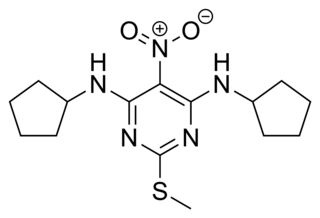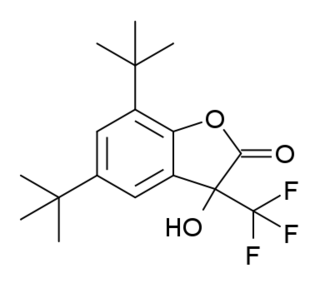
The GABAA receptor (GABAAR) is an ionotropic receptor and ligand-gated ion channel. Its endogenous ligand is γ-aminobutyric acid (GABA), the major inhibitory neurotransmitter in the central nervous system. Accurate regulation of GABAergic transmission through appropriate developmental processes, specificity to neural cell types, and responsiveness to activity is crucial for the proper functioning of nearly all aspects of the central nervous system (CNS). Upon opening, the GABAA receptor on the postsynaptic cell is selectively permeable to chloride ions (Cl−) and, to a lesser extent, bicarbonate ions (HCO3−).
GABAB receptors (GABABR) are G-protein coupled receptors for gamma-aminobutyric acid (GABA), therefore making them metabotropic receptors, that are linked via G-proteins to potassium channels. The changing potassium concentrations hyperpolarize the cell at the end of an action potential. The reversal potential of the GABAB-mediated IPSP is –100 mV, which is much more hyperpolarized than the GABAA IPSP. GABAB receptors are found in the central nervous system and the autonomic division of the peripheral nervous system.
The GABAA-rho receptor is a subclass of GABAA receptors composed entirely of rho (ρ) subunits. GABAA receptors including those of the ρ-subclass are ligand-gated ion channels responsible for mediating the effects of gamma-amino butyric acid (GABA), the major inhibitory neurotransmitter in the brain. The GABAA-ρ receptor, like other GABAA receptors, is expressed in many areas of the brain, but in contrast to other GABAA receptors, the GABAA-ρ receptor has especially high expression in the retina.

DMCM is a drug from the β-carboline family. It acts as a negative allosteric modulator of GABAA receptors, meaning that it causes the opposite effects to the benzodiazepine class of drugs. As such, DMCM has anxiogenic and convulsant properties, and is used in scientific research to induce anxiety so that new anxiolytic medications can be tested, and to produce convulsions so that anticonvulsant medications can be tested. It has also been shown to produce analgesic effects in animals, thought to be because it produces panic which reduces the perception of pain.

A GABA receptor agonist is a drug that is an agonist for one or more of the GABA receptors, producing typically sedative effects, and may also cause other effects such as anxiolytic, anticonvulsant, and muscle relaxant effects. There are three receptors of the gamma-aminobutyric acid. The two receptors GABA-α and GABA-ρ are ion channels that are permeable to chloride ions which reduces neuronal excitability. The GABA-β receptor belongs to the class of G-Protein coupled receptors that inhibit adenylyl cyclase, therefore leading to decreased cyclic adenosine monophosphate (cAMP). GABA-α and GABA-ρ receptors produce sedative and hypnotic effects and have anti-convulsion properties. GABA-β receptors also produce sedative effects. Furthermore, they lead to changes in gene transcription.

Imidazenil is an experimental anxiolytic drug which is derived from the benzodiazepine family, and is most closely related to other imidazobenzodiazepines such as midazolam, flumazenil, and bretazenil.

8-OH-DPAT is a research chemical of the aminotetralin chemical class which was developed in the 1980s and has been widely used to study the function of the 5-HT1A receptor. It was one of the first major 5-HT1A receptor full agonists to be discovered.

L-838,417 is an anxiolytic drug used in scientific research. It has similar effects to benzodiazepine drugs, but is structurally distinct and so is classed as a nonbenzodiazepine anxiolytic. The compound was developed by Merck, Sharp and Dohme.

Homotaurine is a natural sulfonic acid found in seaweed. It is analogous to taurine, but with an extra carbon in its chain. It has GABAergic activity, apparently by mimicking GABA, which it resembles.

TP-003 is an anxiolytic drug with a novel chemical structure, which is used in scientific research. It has similar effects to benzodiazepine drugs, but is structurally distinct and so is classed as a nonbenzodiazepine anxiolytic. It is a positive allosteric modulator at the benzodiazepine binding site of GABAA receptors. It has modest anticonvulsant activity although less than that of diazepam.

GS-39783 is a compound used in scientific research which acts as a positive allosteric modulator at the GABAB receptor. It has been shown to produce anxiolytic effects in animal studies, and reduces self-administration of alcohol, cocaine and nicotine.

BHFF is a compound used in scientific research which acts as a positive allosteric modulator at the GABAB receptor. It has anxiolytic effects in animal studies, and good oral bioavailability.

BSPP is a compound used in scientific research which acts as a positive allosteric modulator at the GABAB receptor. It has a synergistic effect with GABAB agonists such as baclofen at GABAB autoreceptors but not heteroreceptors, suggesting it may be useful for distinguishing between these GABAB receptor subtypes.

BHF-177 is a compound used in scientific research which acts as a positive allosteric modulator at the GABAB receptor. It was shown to reduce self-administration of nicotine in animal studies.

PHCCC is a research drug which acts as a glutamate receptor ligand, particularly being a positive allosteric modulator at the mGluR4 subtype, as well as an agonist at mGluR6. It has anxiolytic effects in animal studies. PHCCC and similar drugs have been suggested as novel treatments for Parkinson's disease.

SKF-97,541 is a compound used in scientific research which acts primarily as a selective GABAB receptor agonist. It has sedative effects in animal studies and is widely used in research into potential treatment of various types of drug addiction.

MGS-0039 is a drug that is used in neuroscientific research, which acts as a potent and selective antagonist for group II of the metabotropic glutamate receptors (mGluR2/3). It produces antidepressant and anxiolytic effects in animal studies, and has been shown to boost release of dopamine and serotonin in specific brain areas. Research has suggested this may occur through a similar mechanism as that suggested for the similarly glutamatergic drug ketamine.

SB-243213 is a research chemical which acts as a selective inverse agonist for the 5HT2C receptor and has anxiolytic effects. It has better than 100x selectivity for 5-HT2C over all other receptor subtypes tested, and a longer duration of action compared to older 5-HT2C antagonist ligands.
















